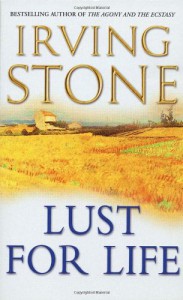
Written with a passion reminiscent of Vincent Van Gogh's paintings, Irving Stone's "Lust for Life" is a fictionalized biography of the famed post-Impressionist painter.Stone starts his story during Van Gogh's teenaged years, living with his strict Calvinist parents (his father was a predikant, a Dutch Calvinist minister), somewhat struggling against the strictures of his life. He himself becomes a Calvinist evangelist and receives a less-than-desirable assignment to a Belgian coal-mining town.It is there that his interest in art begins, as he starts to sketch the peasants around him. Van Gogh sees beauty in the workaday world and "regular people," far moreso than in models and more typically-expressed concepts of art.Stone's story takes Van Gogh through various stages of his life as he develops his art, gets to know his fellow artists (Toulouse-Lautrec, Gauguin (with whom he rather infamously lived for a while in Arles), and discovers his various passions. The most poignant part of the book for me concerns Van Gogh's confinement in a maison de sante (insane asylum) in St. Remy, where the inmates are essentially made to take care of themselves, and how he grows to understand more about himself as a result.Stone's Van Gogh is a man tormented by what we would now probably understand as bipolar disorder. He shows the mania of creation, followed by bleak crises of meaning, literal and figurative hunger and more through well-crafted prose and dialogue. Highly recommended for those interested in the life of this fascinating figure.
 Written with a passion reminiscent of Vincent Van Gogh's paintings, Irving Stone's "Lust for Life" is a fictionalized biography of the famed post-Impressionist painter.Stone starts his story during Van Gogh's teenaged years, living with his strict Calvinist parents (his father was a predikant, a Dutch Calvinist minister), somewhat struggling against the strictures of his life. He himself becomes a Calvinist evangelist and receives a less-than-desirable assignment to a Belgian coal-mining town.It is there that his interest in art begins, as he starts to sketch the peasants around him. Van Gogh sees beauty in the workaday world and "regular people," far moreso than in models and more typically-expressed concepts of art.Stone's story takes Van Gogh through various stages of his life as he develops his art, gets to know his fellow artists (Toulouse-Lautrec, Gauguin (with whom he rather infamously lived for a while in Arles), and discovers his various passions. The most poignant part of the book for me concerns Van Gogh's confinement in a maison de sante (insane asylum) in St. Remy, where the inmates are essentially made to take care of themselves, and how he grows to understand more about himself as a result.Stone's Van Gogh is a man tormented by what we would now probably understand as bipolar disorder. He shows the mania of creation, followed by bleak crises of meaning, literal and figurative hunger and more through well-crafted prose and dialogue. Highly recommended for those interested in the life of this fascinating figure.
Written with a passion reminiscent of Vincent Van Gogh's paintings, Irving Stone's "Lust for Life" is a fictionalized biography of the famed post-Impressionist painter.Stone starts his story during Van Gogh's teenaged years, living with his strict Calvinist parents (his father was a predikant, a Dutch Calvinist minister), somewhat struggling against the strictures of his life. He himself becomes a Calvinist evangelist and receives a less-than-desirable assignment to a Belgian coal-mining town.It is there that his interest in art begins, as he starts to sketch the peasants around him. Van Gogh sees beauty in the workaday world and "regular people," far moreso than in models and more typically-expressed concepts of art.Stone's story takes Van Gogh through various stages of his life as he develops his art, gets to know his fellow artists (Toulouse-Lautrec, Gauguin (with whom he rather infamously lived for a while in Arles), and discovers his various passions. The most poignant part of the book for me concerns Van Gogh's confinement in a maison de sante (insane asylum) in St. Remy, where the inmates are essentially made to take care of themselves, and how he grows to understand more about himself as a result.Stone's Van Gogh is a man tormented by what we would now probably understand as bipolar disorder. He shows the mania of creation, followed by bleak crises of meaning, literal and figurative hunger and more through well-crafted prose and dialogue. Highly recommended for those interested in the life of this fascinating figure.



